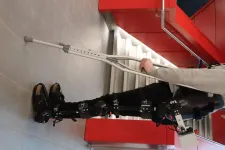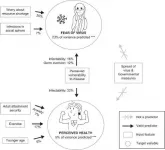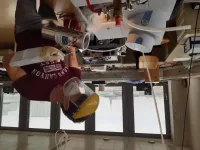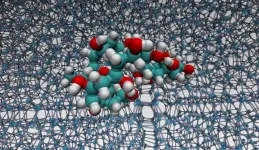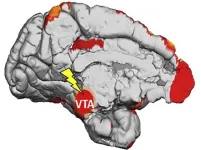(Press-News.org) The U.S. criminal legal system has expanded at a rapid pace, even as crime rates have declined since the 1990s. As a result, individuals' interactions with and surveillance by law enforcement are now commonplace. But citizens experience different interactions, with people of color who live in impoverished urban communities having the most frequent encounters. A new study interviewed young Philadelphia men to determine their perceptions of and reactions to this phenomenon. Nearly all of the men of color said they stayed at home and avoided public spaces out of concern over the potential interactions with others that might draw police attention.
The study, by a researcher at Temple University, appears in Criminology, a publication of the American Society of Criminology.
"This kind of avoidance of being out in the community is a racialized adaptation to the expansion of the criminal legal apparatus and the unpredictable nature of men's interactions with its agents and enforcers," explains Jamie J. Fader, associate professor of criminal justice at Temple University, who conducted the study. "It reproduces the effects of incarceration by turning the men's homes into virtual prisons, and it effectively erases young men of color from the public sphere, with considerable costs for the men and their neighborhoods."
Fader and her team conducted in-depth interviews with 45 men ages 25 to 34 who live in Frankford, Pennsylvania, an impoverished, racially diverse Philadelphia neighborhood with high rates of crime and violence. The area has also been heavily affected by mass incarceration. The study included 23 men who identified as Black, 5 who identified as Latino, and 17 who identified as White. Twenty-six of the men had at least a high school diploma and 19 had less education.
In her study, carried out from 2014 to 2019, Fader sought to learn how the men perceived risk and how they organized their daily routines in response to it. She also explored whether there are racial differences in perceptions and adaptation to risk.
Interviews lasted several hours and covered a range of topics, including daily routines, perceptions of the neighborhood, contact with police, family and social ties, and identity questions centering on stigma, masculinity, and adulthood. Fader and her team examined official criminal records to secure a history of each man's contact with the criminal justice system prior to the interview and new contact in the time after the interview. They also drew information about the Frankford community from five years of regularly observing community meetings, events, and venues.
The Frankford men, particularly the men of color, described a preoccupation with trouble, which they often called "drama," that stemmed from the unpredictable nature of their status vis à vis the criminal legal system, as well as the regular threat posed by street or police violence. Even men who had no prior criminal record or involvement with the criminal justice system expressed concern about venturing out beyond their homes, viewing public spaces as unpredictable and posing an unacceptable level of risk.
This practice of avoiding venturing into their neighborhood often translated into a lack of engagement in their community, whether it be in civic or service organizations or by getting to know neighbors, the study concluded. Fader and her team distinguished those who felt they had no choice but to stay home (identifying them as avoidant) from men who said they had chosen to limit their social contacts because they wanted to avoid social ties (identifying them as isolated). The study also found a systemic lack of men under 40 at community meetings and events in Frankford. The same pattern emerged in observations of barber shops, boxing gyms, and bars.
"Our study features men who came of age during the super-predator scare," says Fader, referring to the since-debunked idea that some impulsive young men carried out violent crimes without remorse. "The justice system, which is ostensibly designed to reduce risk of crime, has actually heightened men's concerns about risk. In addition to fears of victimization by street-level gun violence, these men also worry about the potential for arrest, court involvement and a criminal record, incarceration, and death at the hands of police."
The study has a number of implications, Fader suggests. The vigilance these men need to avoid trouble creates an environment of unrelenting stress, which affects mental and physical health and can reduce life expectancy. The men's avoidance of others limits their ability to develop and maintain social ties, and prevents the accumulation of social capital. It also forces the men to manage the risks they fear alone, without support from social service agencies. And it limits job opportunities, travel, friendships, and community involvement.
Finally, Fader notes, mistrusting social institutions and avoiding public space reduces community engagement, political participation, organizing, protesting, and capacity building, activities that build stronger social infrastructures and are engines of social and personal change.
Fader pointed to several limitations of the study: Because the study focused on one community and interviewed only men, its findings cannot be generalized to other communities or speak to women's experiences. Also, because the study relied on the men's narratives of their activities rather than on direct observation, it is possible that the men characterized themselves as more self-sufficient and independent than they actually were. Finally, about half the White men in the study were in recovery from substance abuse, which may have affected both their assessments of risk and the economic and social support they received from the recovery community.
INFORMATION:
The study was supported by Temple University.
UTICA, NY -- Brown fat, also known as brown adipose tissue (BAT), is a special type of fat that helps maintain body temperature. Importantly, brown fat is a biological fuel linked to metabolic rate and fat storage. In a recent publication, Dr. Zhiqiang Lin, Assistant Professor at the Masonic Medical Research Institute (MMRI) and senior author of the manuscript, successfully developed a new way to enrich isolation of brown fat cells for use in his biochemistry studies. "When faced with a scientific setback, we simply start tackling potential hurdles," said Dr. Lin. One of these was having a need to develop a better way to isolate these fat cells.
BAT is comprised of multiple cell types, which makes it difficult to ...
Between 2015 and 2017, Seattle, Washington, became the first U.S. city to increase its hourly minimum wage to $15, more than double the federal minimum wage and 60 percent higher than Seattle's previous minimum wage. A new study examined the impact of this change on public safety. The study was motivated by the idea that since crime is sometimes the result of material deprivation, changes in the minimum wage might have implications for criminal activity: Boosting the minimum wage could raise workers' salaries (which could be associated with reduced crime). But if higher minimum wages spur employers to substitute capital for labor, this could ...
Increases in the use of telehealth during the coronavirus pandemic among people with private insurance has occurred mostly among those who are more affluent and those who live in metropolitan areas, according to a new RAND Corporation study.
Researchers say the findings raise concerns that the pandemic may be worsening existing disparities in overall health care utilization.
Overall, the study found there was a 20-fold increase in the rate of telemedicine utilization following the outset of the pandemic in March 2020. At the same time, the rate of office-based medical encounters declined by nearly 50% and was not fully offset by the increase in telemedicine.
The findings are published online by the American Journal of Preventive ...
Robotics researchers are developing exoskeletons and prosthetic legs capable of thinking and making control decisions on their own using sophisticated artificial intelligence (AI) technology.
The system combines computer vision and deep-learning AI to mimic how able-bodied people walk by seeing their surroundings and adjusting their movements.
"We're giving robotic exoskeletons vision so they can control themselves," said Brokoslaw Laschowski, a PhD candidate in systems design engineering who leads a University of Waterloo research project called ExoNet.
Exoskeletons ...
In the first all-sky survey by the eROSITA X-ray telescope onboard SRG, astronomers at the Max Planck Institute for Extraterrestrial Physics have identified a previously unknown supernova remnant, dubbed "Hoinga". The finding was confirmed in archival radio data and marks the first discovery of a joint Australian-eROSITA partnership established to explore our Galaxy using multiple wavelengths, from low-frequency radio waves to energetic X-rays. The Hoinga supernova remnant is very large and located far from the galactic plane - a surprising first finding - implying that the next years might bring many more ...
During pandemics, protective behaviors need to be motivated by effective communication. A critical factor in understanding a population's response to such a threat is the fear it elicits, since fear both contributes to motivating protective responses, but can also lead to panic-driven behaviors. Furthermore, lockdown measures affect well-being, making it important to identify protective factors that help to maintain high perceived levels of health during restrictions. An international team of researchers led by scientists from the University of Vienna has now identified psychological predictors of fear and health during the lockdowns. The result of the study, published in PLOS ONE: Individual psychological variables have a much better predictive power than environmental variables.
The ...
We all have a clear picture in mind when we think of metals: We think of solid, unbreakable objects that conduct electricity and exhibit a typical metallic sheen. The behaviour of classical metals, for example their electrical conductivity, can be explained with well-known, well-tested physical theories.
But there are also more exotic metallic compounds that pose riddles: Some alloys are hard and brittle, special metal oxides can be transparent. There are even materials right at the border between metal and insulator: tiny changes in chemical composition turn the metal into an insulator - or vice versa. ...
Cryoprotectants are used to protect biological material during frozen storage
They have to be removed when defrosting, and how much to use and how exactly they inhibit ice recrystallisation is poorly understood
The polymer poly(vinyl)alcohol (PVA) is arguably the most potent ice recrystallisation inhibitor and researchers from the University of Warwick have unravelled how exactly it works.
This newly acquired knowledge base provides novel guidelines to design the next generation of cryoprotectants
When biological material (cells, blood, tissues) is frozen, cryoprotectants are used to prevent the damage associated with the formation of ...
Researchers uncovered for the first time what happens in animals' brains when they learn from subconscious, visual stimuli. In time, this knowledge can lead to new treatments for a number of conditions. The study, a collaboration between KU Leuven, Massachusetts General Hospital, and Harvard was published in Neuron.
An experienced birdwatcher recognises many more details in a bird's plumage than the ordinary person. Thanks to extensive training, he or she can identify specific features in the plumage. This learning process is not only dependent on conscious processes. Previous research has shown that when people are rewarded during the presentation of visual stimuli that are not consciously perceivable, ...
Researchers from Skoltech and the Massachusetts Institute of Technology have analyzed several dozen options to pick the best one in terms of performance and costs for the 'last mile' of a future mission to the Moon - actually delivering astronauts to the lunar surface and back up to the safety of the orbiting lunar station. The paper was published in the journal Acta Astronautica.
Ever since December 1972, when the crew of Apollo 17 left the lunar surface, humans have been eager to return to the Moon. In 2017, the US government launched the Artemis program, which intends ...
